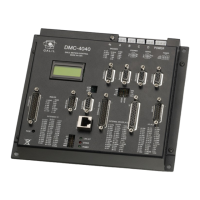Motor Connector ( Brushed or 3 phase Brushless )
1 Phase C
2 Phase B (N/C for Brushed Motors)
3 No Connect
4 Phase A
Motor Connector ( 2 Phase Brushless [2PB] )
1 Phase B-
2 Phase B+
3 Phase A-
4 Phase A+
Operation
Commutation Related Velocity
When using sinusoidal commutation and higher speed applications, it is a good idea to calculate the speed at which
commutation can start to affect performance of the motor. In general, it is recommended that there be at least 8
servo samples for each magnetic cycle. The time for each sample is defined by TM, “TM 1000” is default and is in
units of μs per sample or [μs/sample]. TM can be lowered to achieve higher speeds.
Below is the equation that can be used to calculate the desired maximum commutation speed in counts per second
[cts/s]:
Speed
[cts/ s ]
=
m×10
6
(TM ×n)
Where,
is the number of counts per magnetic cycle [cts/magnetic cycle]
is the desired number of (TM) samples per magnetic cycle (8 or more recommended) [samples/magnetic
cycle ]
Example:
Assume that an encoder provides 4000 [cts/rev] and that a motor has 2 pole pairs. Each pole pair represents a
single magnetic cycle.
can be calculated as follows:
m=
4000
[cts /rev ]
2
[magneticcycles ]
=2000
[cts/ magnetic cycle]
If “TM 250” is set and 8 servo samples per magnetic cycle is desired, the maximum speed in counts per second
would be:
Speed =
2000
[cts / magneticcycle ]
×10
[μs/ s ]
6
250
[μs / sample]
×8
[samples / magneticccycle]
=1,000,000
[cts/ s ]
Setting up the Brushless Mode and finding proper commutation
Using the D3540 requires version 1.1d revision firmware or higher; be sure this is installed on your controller:
A4 – AMP-435x0 (-D3540,-D3520) ▫ 230 DMC-40x0 User Manual

